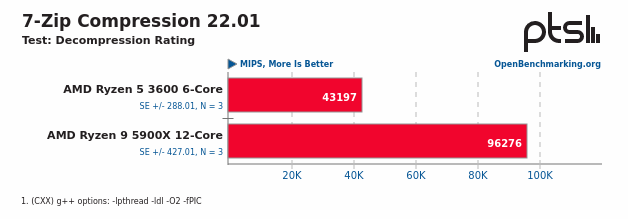PC Upgrades Ryzen 5900x
My main desktop PC I built at the end of 2019, luckily before the prices went up considerable.
It consisted of
- Ryzen 5 3600 - a great value 6-core, 12-thread processor at the time
- 16GB as 2x 8GB Corsair Vengeance LPX 3000MHz CL15 DDR4 RAM
- GeForce GTX 1660 6GB Graphics Card - Zotac Twin Fan
- Kingston A2000 500GB NVMe SSD
- Gigabyte B450 I AORUS PRO AMD AM4 motherboard
- Corsair SF450 Platinum PSU
- Thermalright AXP90 47mm CPU cooler - full copper version
- all in a Kolink Rocket ITX case running 2x 80mm and 1x 60mm Noctua fans
It cost at the time a little under £900, ignoring the mistake of trying to save money on the PSU. I didn't buy Windows and instead run Linux Mint (19 at the time), and I've learnt to prefer it to Windows and now use Linux on all my machines.
Gosh - more than I thought actually, but still much better than any pre-built machine of the same price, and there is a premium for smaller ITX builds.
Now prices have becomes reasonable and the latest generations of processors are out (with DDR5 RAM) - I decided to ignore the latest available for the first time and just upgrade what I can to almost the best of what the AM4 motherboard can support.

The biggest purchase was the CPU, a 12-core 24-thread Ryzen 9 5900X. It's one below the best the AM4 platform can offer and I managed to get a returned CPU for £290.
In the smaller ITX case, it makes sense to apply the 'eco mode' setting to the CPU, which caps the typical power to 65W, same as the Ryzen 5 3600. Benchmarks showed a decent score, but somewhat below other systems with the same CPU.
Curve optimiser helped further. A -25 curve gave a decent improvement in scores and a general reduction in heat - so well worth doing. It did eventually crash once though so I've settled on -22 now.
I also upgraded the RAM. A couple of times I've run out of the 16GB available, so a 32GB upgrade sounded good. Corsair Vengeance LPX works well in the system, and it's good value so I found 2x 16GB sticks for £70. These run at 3600MHz, which helps AMD processors with their chiplet design.
Now my benchmarks are pretty good on the limited testing I did. Still a bit under other comparable systems - but remember I'm running eco mode here and not overclocking. For me, it's damn quick!
The final upgrade was the SSD. 500GB was down to just 20GB free with games installed, dev tools and VMs. 1TB SSDs are now very reasonable, but you still have to pay a premium for a quicker model.
Since this is a gaming and productivity machine running decent hardware, I picked a higher tier NVMe SSD - the WD Black SN850X. Again another return due to packaging torn, so just £77. That's only a little more than my 500GB ssd cost back in 2019.
This SSD reviews well, comes with DRAM and a large SLC cache, so it's quick!
To upgrade, I cloned my entire disk by placing it an NVMe to USB3 caddy. To clone my entire system, I booted with a Linux Mint USB drive and used dd to make a direct copy of /dev/sdb (my old drive in the USB caddy) to /dev/nvme0n1 (the new disk in the main motherboard slot).
dd if=/dev/sdb of=/dev/nvme0n1 bs=64K conv=noerror,sync status=progress
The clone took a while, I probably should have tried a larger block size, but I left it running whilst having dinner and watching TV. After that, I used gparted to resize the lvm partition and shut down the live USB instance.
OS booted straight away, no problems! The only thing was my free space was still low because the physical and logical volumes needed expanding. At the same time, I also increased the size of the swap lvm from 1GB to 16GB, so if I do run out of RAM, at least my system will eventually respond instead of crashing programs.
First, expanding the physical volume to fill the partition expanded by gparted in the live session earlier:
sudo pvdisplay sudo pvresize /dev/nvme0n1p2 sudo pvdisplay
Then turn off swap, expand the swap volume (from 1GB to 16GB, so +15GB), and turn it back on again, with verification.
sudo lvdisplay sudo swapoff -v /dev/vgmint/swap_1 sudo lvresize /dev/vgmint/swap_1 -L +15G sudo mkswap /dev/vgmint/swap_1 sudo swapon -va cat /proc/swaps free
The root lvm can then be expanded to 100% of the free physical space left, followed by resizing the file system. This can be done online even though I've booted from this root volume. I had to google the commands, but it worked and after the clone, making the system ready with the extra space took about 10 minutes.
sudo lvextend -l +100%FREE /dev/vgmint/root sudo resize2fs /dev/vgmint/root
So, £380 of upgrades, but I'll get some money back (though only about £80 after selling fees) for the old CPU, RAM (I'll keep the disk). If I went for the latest AM5 Zen 4 or Intel 13th Gen processors (as great as they both are), it would have been much more expensive to change the motherboard and DDR5 RAM.
This should hopefully last years, and maybe one day I'll upgrade the graphics card too as gaming benchmarks barely moved. I don't game that often on the desktop and the GTX 1660 is working well enough for driving a FHD resolution monitor though.





